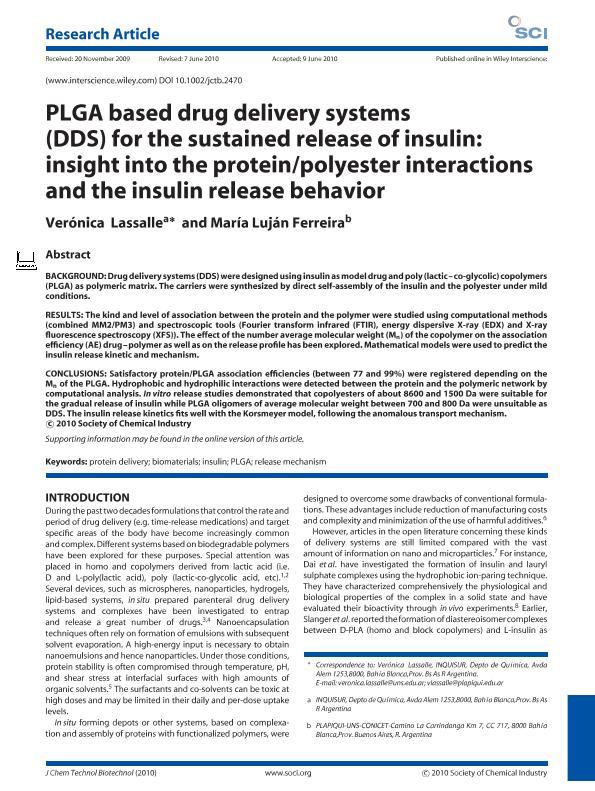Mostrar el registro sencillo del ítem
dc.contributor.author
Lassalle, Verónica Leticia

dc.contributor.author
Ferreira, María Luján

dc.date.available
2018-11-09T14:49:54Z
dc.date.issued
2010-12
dc.identifier.citation
Lassalle, Verónica Leticia; Ferreira, María Luján; PLGA based drug delivery systems (DDS) for the sustained release of insulin: Insight into the protein/polyester interactions and the insulin release behavior; John Wiley & Sons Ltd; Journal of Chemical Technology and Biotechnology; 85; 12; 12-2010; 1588-1596
dc.identifier.issn
0268-2575
dc.identifier.uri
http://hdl.handle.net/11336/64071
dc.description.abstract
BACKGROUND: Drug delivery systems (DDS) were designed using insulin as model drug and poly (lactic-co-glycolic) copolymers (PLGA) as polymeric matrix. The carriers were synthesized by direct self-assembly of the insulin and the polyester under mild conditions. RESULTS: The kind and level of association between the protein and the polymer were studied using computational methods (combined MM2/PM3) and spectroscopic tools (Fourier transform infrared (FTIR), energy dispersive X-ray (EDX) and X-ray fluorescence spectroscopy (XFS)). The effect of the number average molecular weight (Mn) of the copolymer on the association efficiency (AE) drug-polymer as well as on the release profile has been explored. Mathematical models were used to predict the insulin release kinetic and mechanism. CONCLUSIONS: Satisfactory protein/PLGA association efficiencies (between 77 and 99%) were registered depending on the Mn of the PLGA. Hydrophobic and hydrophilic interactions were detected between the protein and the polymeric network by computational analysis. In vitro release studies demonstrated that copolyesters of about 8600 and 1500 Da were suitable for the gradual release of insulin while PLGA oligomers of average molecular weight between 700 and 800 Da were unsuitable as DDS. The insulin release kinetics fits well with the Korsmeyer model, following the anomalous transport mechanism. © 2010 Society of Chemical Industry.
dc.format
application/pdf
dc.language.iso
eng
dc.publisher
John Wiley & Sons Ltd

dc.rights
info:eu-repo/semantics/openAccess
dc.rights.uri
https://creativecommons.org/licenses/by-nc-sa/2.5/ar/
dc.subject
Biomaterials
dc.subject
Insulin
dc.subject
Plga
dc.subject
Protein Delivery
dc.subject
Release Mechanism
dc.subject.classification
Biotecnología Industrial

dc.subject.classification
Biotecnología Industrial

dc.subject.classification
INGENIERÍAS Y TECNOLOGÍAS

dc.title
PLGA based drug delivery systems (DDS) for the sustained release of insulin: Insight into the protein/polyester interactions and the insulin release behavior
dc.type
info:eu-repo/semantics/article
dc.type
info:ar-repo/semantics/artículo
dc.type
info:eu-repo/semantics/publishedVersion
dc.date.updated
2018-11-05T19:07:30Z
dc.journal.volume
85
dc.journal.number
12
dc.journal.pagination
1588-1596
dc.journal.pais
Reino Unido

dc.journal.ciudad
Londres
dc.description.fil
Fil: Lassalle, Verónica Leticia. Consejo Nacional de Investigaciones Científicas y Técnicas. Centro Científico Tecnológico Conicet - Bahía Blanca. Instituto de Química del Sur. Universidad Nacional del Sur. Departamento de Química. Instituto de Química del Sur; Argentina
dc.description.fil
Fil: Ferreira, María Luján. Consejo Nacional de Investigaciones Científicas y Técnicas. Centro Científico Tecnológico Conicet - Bahía Blanca. Planta Piloto de Ingeniería Química. Universidad Nacional del Sur. Planta Piloto de Ingeniería Química; Argentina
dc.journal.title
Journal of Chemical Technology and Biotechnology

dc.relation.alternativeid
info:eu-repo/semantics/altIdentifier/doi/https://dx.doi.org/10.1002/jctb.2470
dc.relation.alternativeid
info:eu-repo/semantics/altIdentifier/url/https://onlinelibrary.wiley.com/doi/full/10.1002/jctb.2470
Archivos asociados
